Experimental Investigation of the Performance of Corn Straw Fiber Cement-Stabilized Macadam
Abstract
1. Introduction
2. Materials and Methods
2.1. Materials
2.1.1. Corn Straw Fiber
2.1.2. Cement
2.1.3. Aggregates
2.2. Test Scheme and Method
2.2.1. General Test Program
2.2.2. Specific Test Methods
- Compaction characteristics test: The compaction test was conducted in accordance with T0804 of the Chinese standard (JTG E51-2009). To reduce the error, parallel tests were also conducted for the four groups. The effect of the incorporated fiber on compaction characteristics was investigated by the variation of the optimum moisture content and maximum dry density.
- Mechanical properties test: The mechanical strength test was conducted according to the Chinese standard (JTG E51-2009). Specimens were compacted and formed under an optimal moisture content and the maximum dry density. After maintenance, the specimen was subjected to unconfined compressive strength and splitting test according to T 0805 and T 0806 (JTG E51-2009), and the impact of mechanical properties was characterized by strength changes.
- Dry shrinkage test: Beam-type specimens with dimensions of 100 mm × 100 mm × 400 mm were investigated according to T 0854 (JTG E51-2009). The dry shrinkage chamber was controlled at relative humidity values of 20 ± 1 °C and 60 ± 5%. The dial indicator reading and specimen quality were recorded every day, and the drying shrinkage coefficient was calculated according to the drying shrinkage strain and water loss rate of the specimen (ratio of the strain of a specimen to its water loss rate).
- Dry–wet cycle durability test: Artificially accelerated changes in humidity were used to simulate dry–wet cycles in a natural climate. After standard maintenance for 28 days, the specimens were first immersed in water at room temperature for 20 h, dried at room temperature air for 4 h, then placed in an oven at 60 °C for 20 h, and finally cooled under room temperature air for 4 h. This process corresponded to one cycle. After 5, 10, and 15 cycles of treatment, the compressive strength and splitting strength of the specimens were tested for the decay law analysis of mechanical strength.
3. Results and Discussion
3.1. Compression Density Characteristics of the Mix
3.2. Mechanical Properties
3.3. Dry Shrinkage Performance
3.4. Dry–Wet Cycle Durability
4. Conclusions
- With the increase in the fiber content, the optimum moisture content of cement-stabilized macadam increases, and the maximum dry density generally decreases. However, the addition of a small amount of corn straw fiber marginally affects the compaction characteristics of the cement-stabilized macadam mixture.
- The addition of corn straw fiber significantly enhances the splitting strength of cement-stabilized macadam, thereby decreasing the compressive strength in the early stage and increasing the strength in the later stage. At a fiber content and length of 1% and 10 mm, respectively, the fiber exhibits the best effect on the mechanical strength improvement of cement-stabilized macadam.
- The corn straw fiber effectively reduces the dry shrinkage strain of cement-stabilized macadam and exhibits clear benefits in the inhibition of shrinkage cracking of cement-stabilized macadam. At a fiber content and length of 1% and 15 mm, respectively, the fiber exerts the best effect, and the dry shrinkage coefficient is reduced by 29% compared with that of ordinary cement-stabilized macadam.
- The addition of corn straw fiber significantly delays the decay of the mechanical strength of cement-stabilized macadam caused by dry–wet cycles and improves the durability of cement-stabilized macadam.
Author Contributions
Funding
Institutional Review Board Statement
Informed Consent Statement
Data Availability Statement
Acknowledgments
Conflicts of Interest
References
- Pang, C.; Tang, Z.; Yang, Z.; Huang, P. Review of early strength agent and its mechanism in cement-based materials. Mater. Rep. 2023, 9, 1–18. Available online: http://kns.cnki.net/kcms/detail/50.1078.tb.20220707.1048.006.html (accessed on 30 November 2022).
- Xiong, Y.; Qu, H.; Yang, Y.; Wang, X. Study on the fatigue performance of polyvinyl alcohol fiber cement stabilized macadam. Bull. Chin. Ceram. Soc. 2022, 41, 3493–3500. [Google Scholar] [CrossRef]
- Song, J.; Xu, C. Experimental study on properties of different aggregates stabilized by fiber-reinforced cement. Highway 2022, 67, 237–241. [Google Scholar]
- Luo, K. Research on the crack resistance of cement-stabilized macadam mixed with polyvinyl alcohol fiber. Hunan Commun. Sci. Technol. 2021, 47, 63–65+97. [Google Scholar]
- Yang, L.; Yan, H.; Tang, D. Study on properties of polypropylene fiber reinforced recycled cement stabilized macadam base material. Subgrade Eng. 2021, 3, 110–114. [Google Scholar] [CrossRef]
- Sheng, Y.; Li, L.; Guan, B.; Zhou, H.; He, R.; Chen, H. Research on road performance of brucite fiber early strength cement stabilized macadam in alpine regions. J. Glaciol. Geocryol. 2018, 40, 355–361. [Google Scholar]
- Lu, X. Research progress of plant fiber reinforced cement matrix composites. Low Temp. Constr. Technol. 2020, 42, 28–31. [Google Scholar] [CrossRef]
- Waqas, A.; Syed, H.F.; Muhammad, U.; Mehran, K.; Ayaz, A.; Fahid, A.; Rayed, A.-Y.; Hisham, A.-A.; Muhammad, S. Effect of Coconut Fiber Length and Content on Properties of High Strength Concrete. Materials 2020, 13, 1075. [Google Scholar] [CrossRef] [PubMed]
- Liu, G.; Liao, Y.; Liu, L.; Qiu, L.; Guo, D. Experimental study on mechanical properties and self-shrinkage of ramie fiber cement-based materials. J. Funct. Mater. 2019, 50, 7176–7181. [Google Scholar]
- Katman, H.Y.B.; Khai, W.J.; Bheel, N.; Kırgız, M.S.; Kumar, A.; Benjeddou, O. Fabrication and Characterization of Cement-Based Hybrid Concrete Containing Coir Fiber for Advancing Concrete Construction. Buildings 2022, 12, 1450. [Google Scholar] [CrossRef]
- de Lima, T.E.S.; de Azevedo, A.R.G.; Marvila, M.T.; Candido, V.S.; Fediuk, R.; Monteiro, S.N. Potential of Using Amazon Natural Fibers to Reinforce Cementitious Composites: A Review. Polymers 2022, 14, 647. [Google Scholar] [CrossRef] [PubMed]
- Dayananda, N.; Gowda, B.S.K.; Prasad, G.L.E. A Study on Compressive Strength Attributes of Jute Fiber Reinforced Cement Concrete Composites. IOP Conf. Ser. Mater. Sci. Eng. 2018, 376, 012069. [Google Scholar] [CrossRef]
- Crucho, J.; Picado-Santos, L.; Neves, J. Mechanical Performance of Cement Bound Granular Mixtures Using Recycled Aggregate and Coconut Fiber. Appl. Sci. 2022, 12, 1936. [Google Scholar] [CrossRef]
- Zhou, C.; Cai, L.; Chen, Z.; Li, J. Effect of kenaf fiber on mechanical properties of high-strength cement composites. Constr. Build. Mater. 2020, 263, 121007. [Google Scholar] [CrossRef]
- Rama Rao, P.; Ramakrishna, G. Experimental Investigation on Mechanical Properties of Oil Palm Empty Fruit Bunch Fiber Reinforced Cement Mortar. Mater. Today Proc. 2021, 46, 471–477. [Google Scholar] [CrossRef]
- Chen, Z. Study on the Adsorption Mechanism of Corn Straw Fiber Asphalt and its SMA Road Performance. Ph.D. Thesis, Harbin Institute of Technology, Harbin, China, 2021. [Google Scholar] [CrossRef]
- Wang, D. Research on the Influence of Sisal Fiber on the Crack Resistance of Cement-Stabilized Macadam Base. Master’s Thesis, Chang’an University, Xi’an, China, 2017. [Google Scholar]
- Research Institute of Highway Ministry of Transport, Anhui Transportation Holding Group Co., Ltd.; Fujian Provincial Expressway Construction Headquarters. Fiber for Asphalt Pavement: JT/T 533-2020[S]; China Communications Press: Beijing, China, 2020. [Google Scholar]
- Yang, L. Performance Study of Modified Straw-Cement Matrix Composites. Master’s Thesis, Wuhan Polytechnic University, Wuhan, China, 2020. [Google Scholar] [CrossRef]
- Van Nguyen, C.; Mangat, P.S. Properties of rice straw reinforced alkali activated cementitious composites. Constr. Build. Mater. 2020, 261, 120536. [Google Scholar] [CrossRef]
- Zhang, Z. Experimental Study on Road Performance of Fiber Cement Stabilized Macadam Base. Master’s Thesis, Hefei University of Technology, Hefei, China, 2020. [Google Scholar] [CrossRef]
- Wu, R. Study on Pavement Performance of Polyvinyl Alcohol Fiber Cement Stabilizing Gravel. Master’s Thesis, Chang’an University, Xi’an, China, 2020. [Google Scholar] [CrossRef]
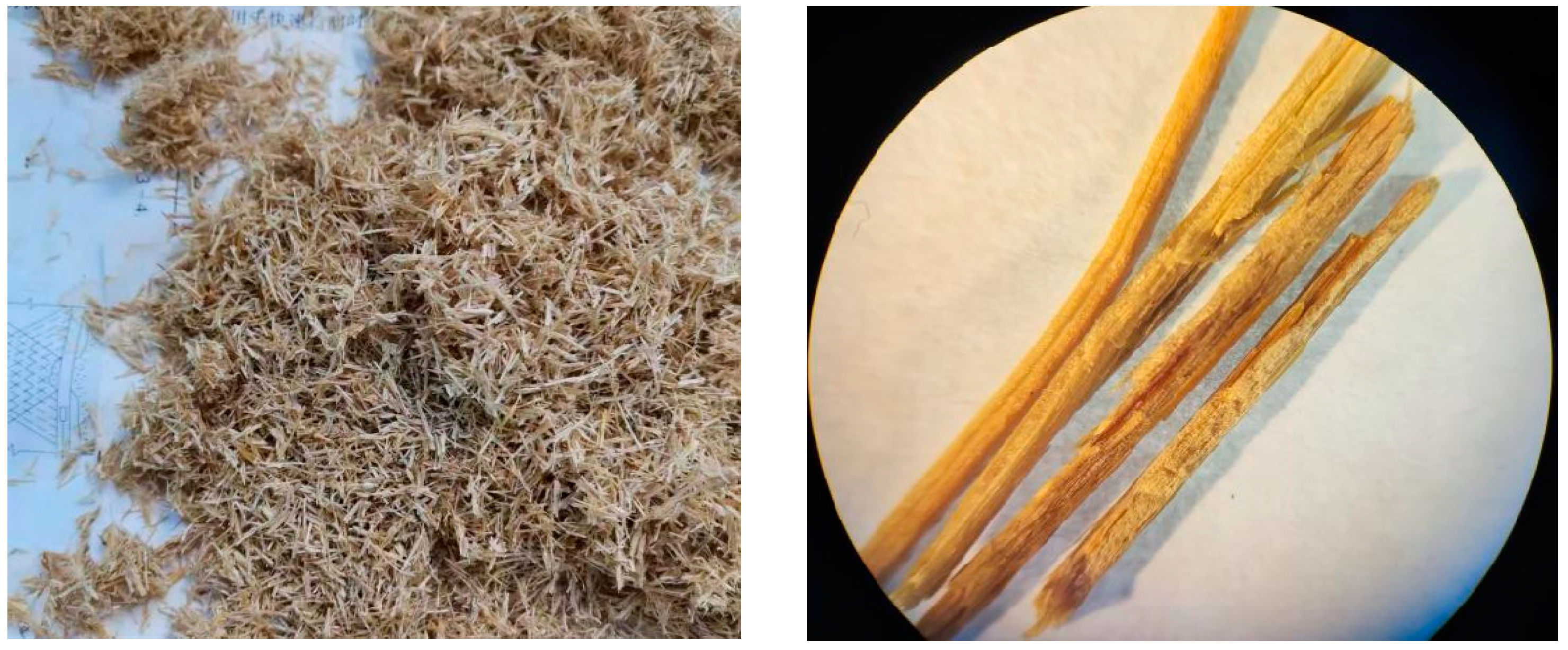

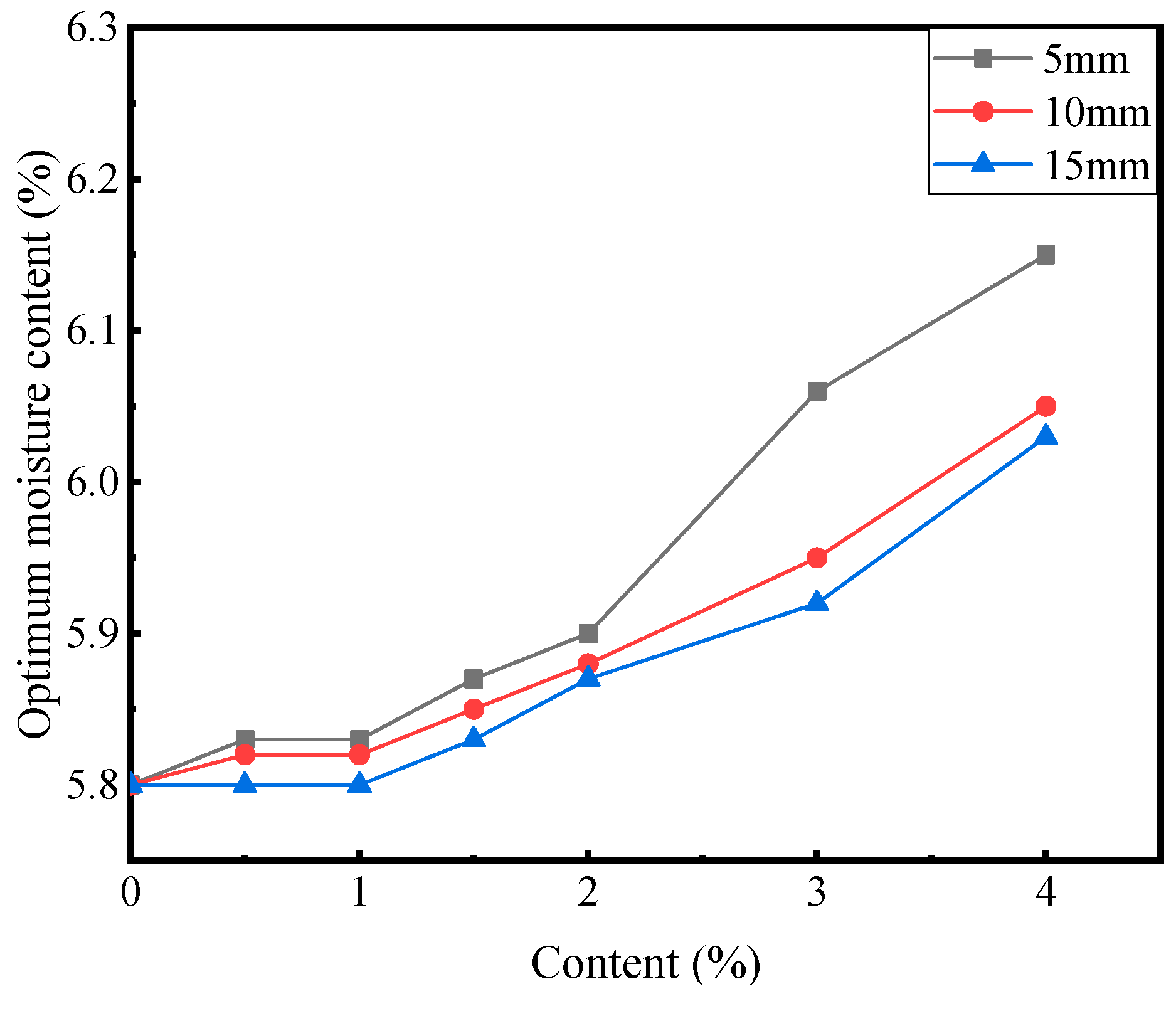
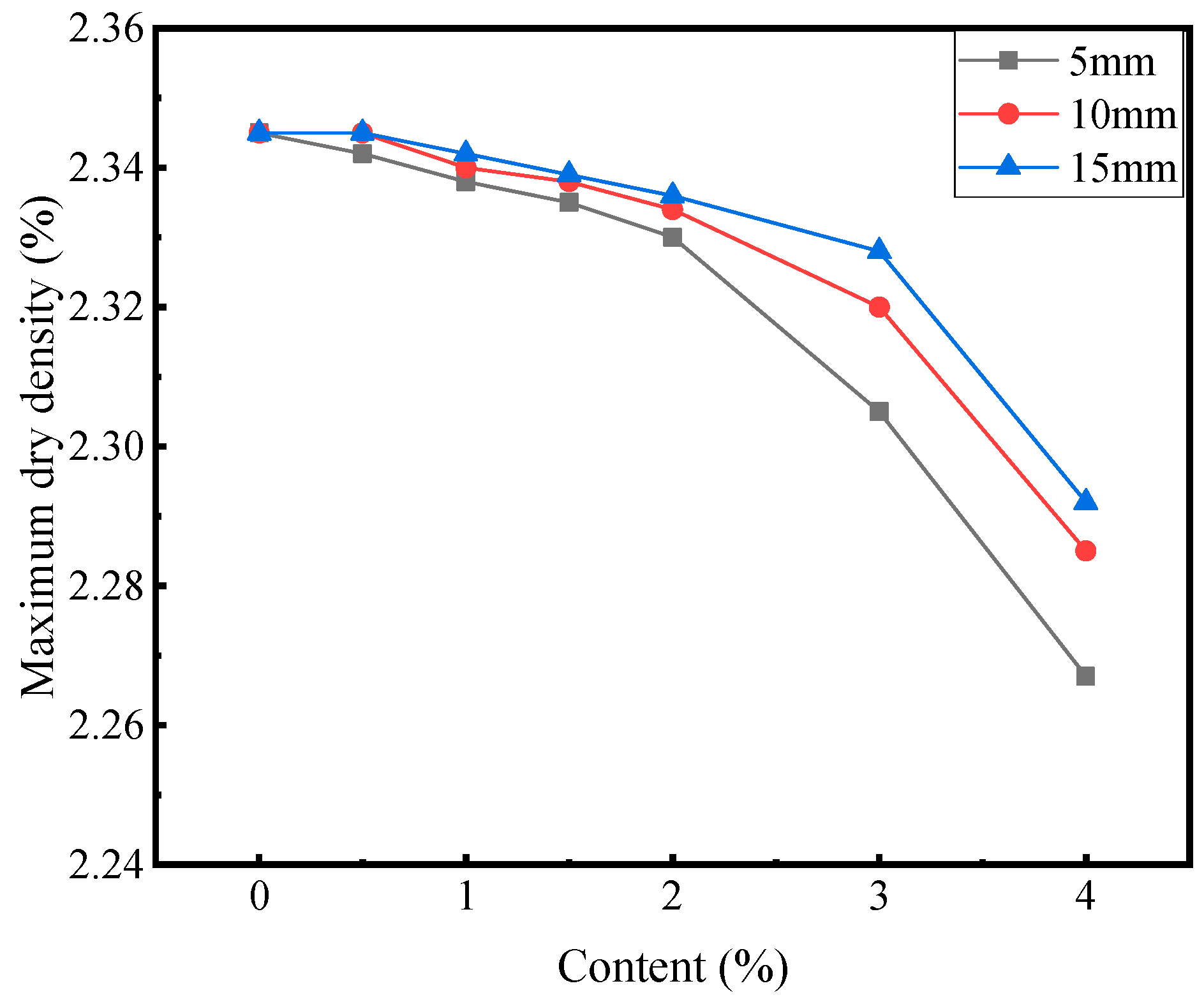
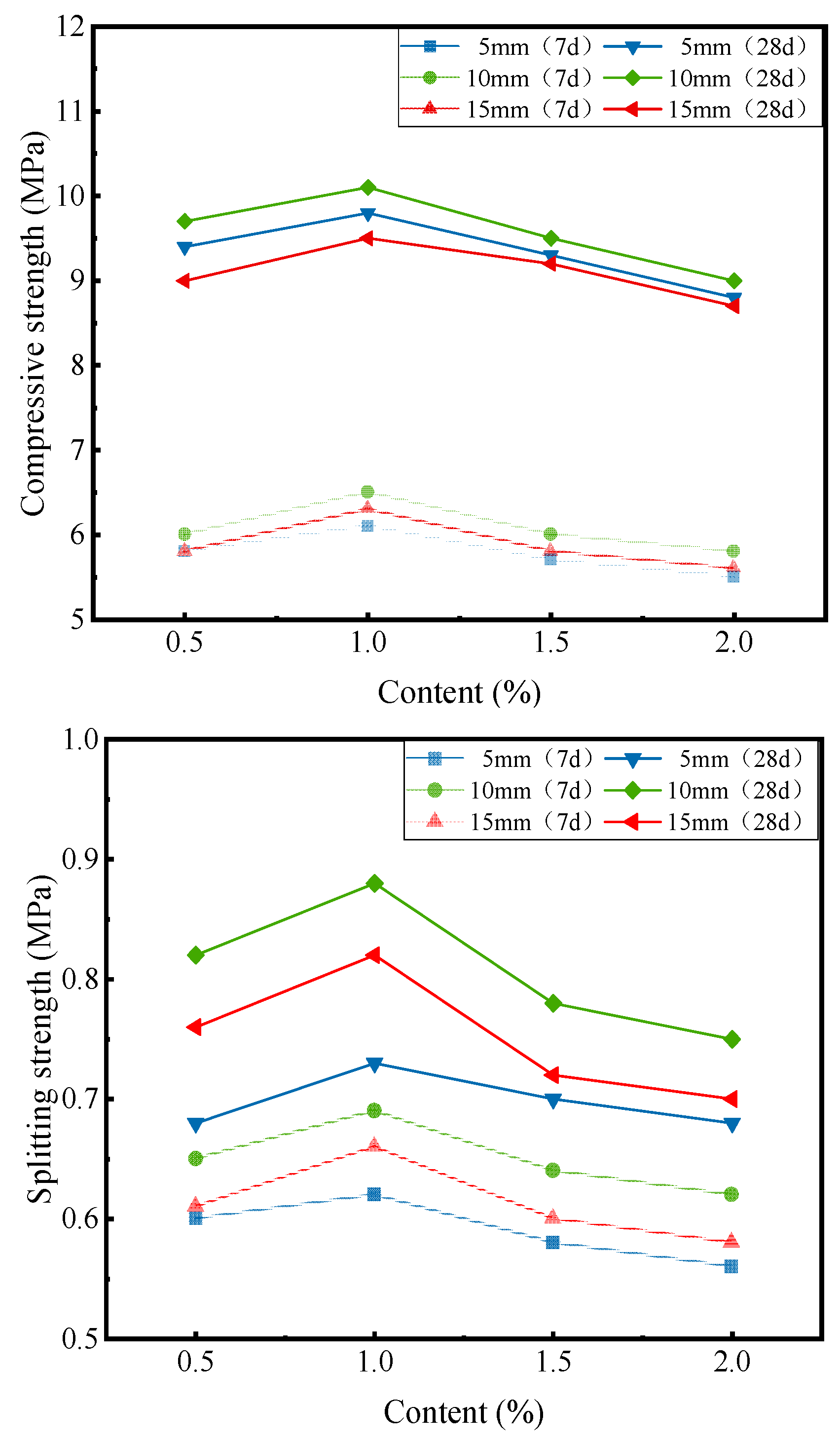
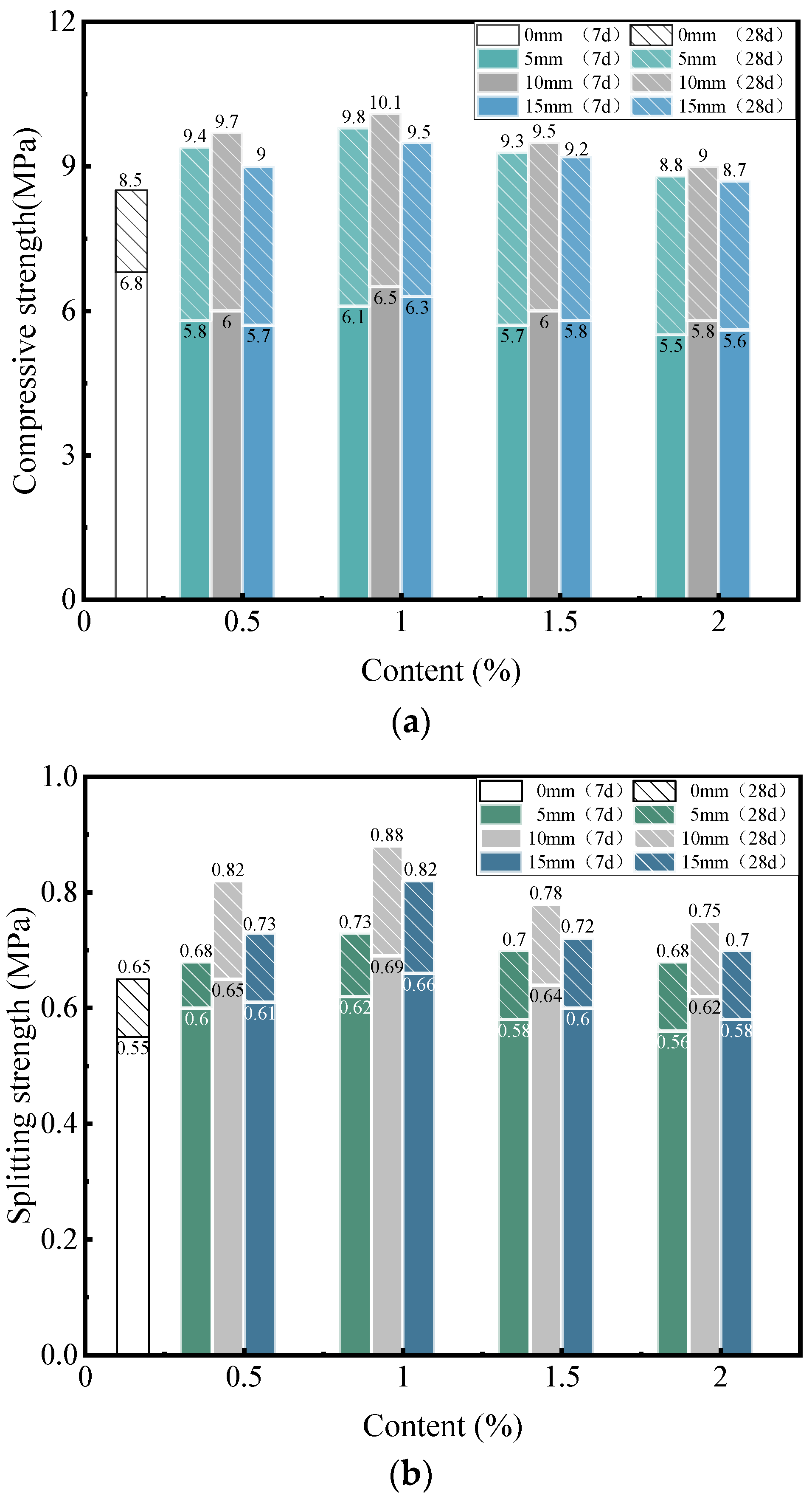
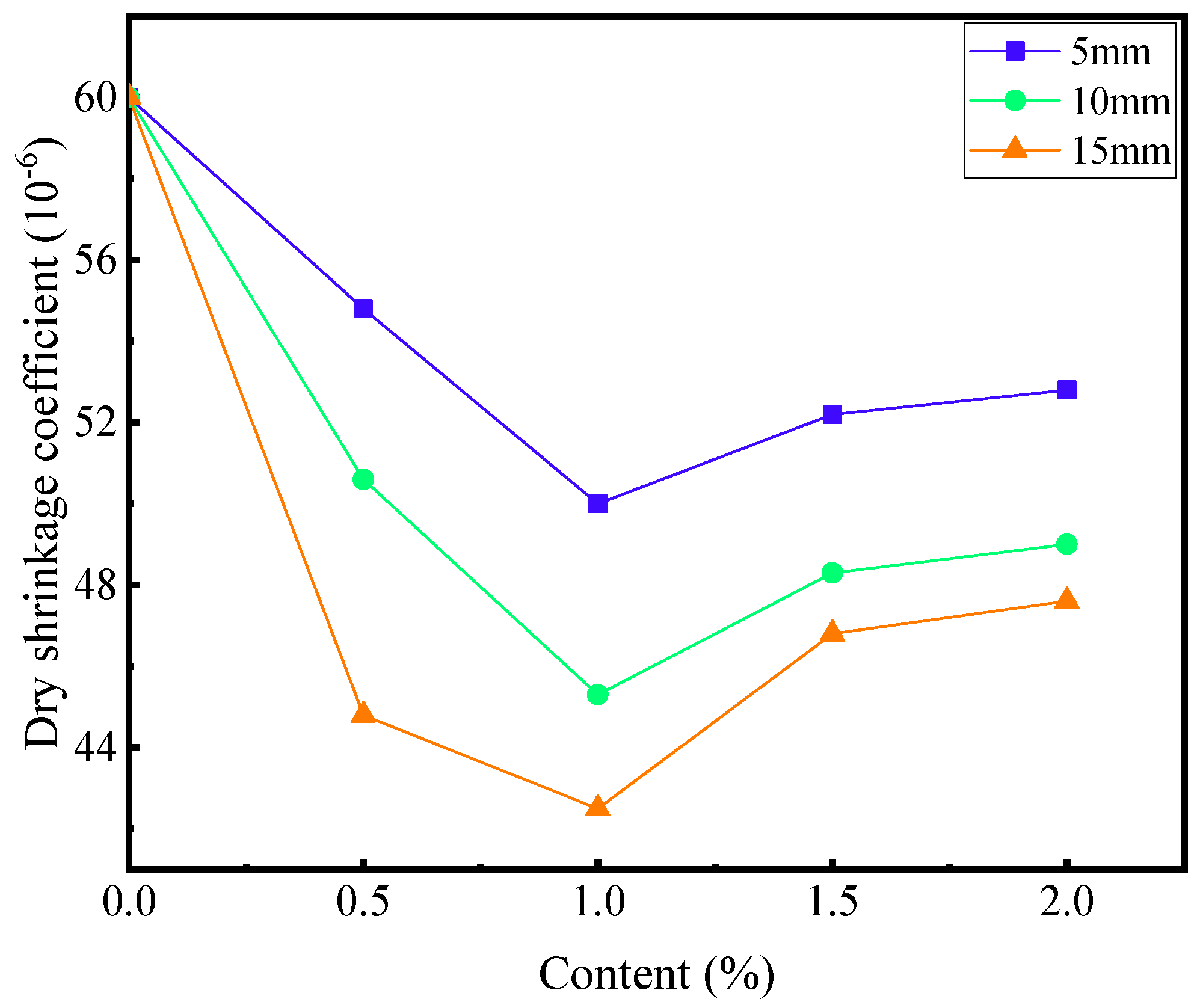
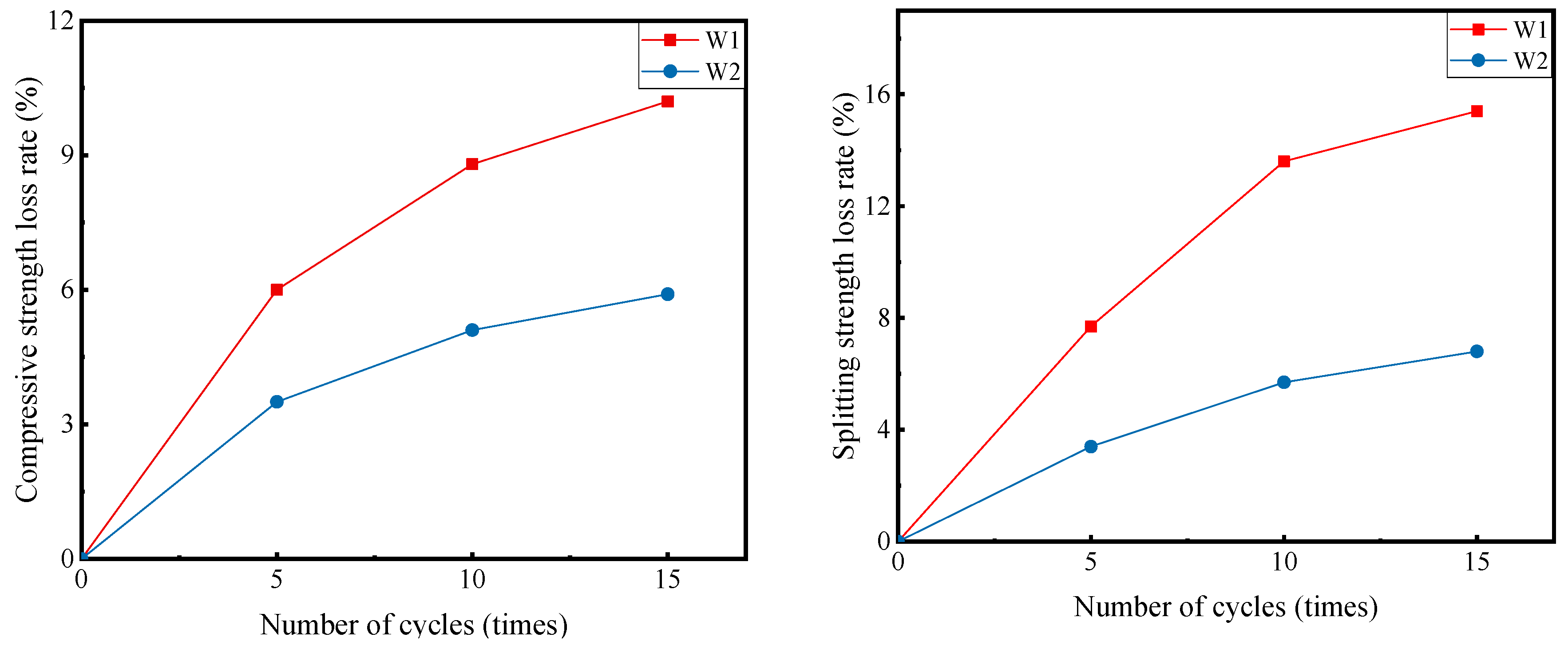
| Characteristics | Density [g·cm−3] | Water Content [%] | Water Absorption [%] | Ash [%] | pH Value |
|---|---|---|---|---|---|
| Test results | 1.32 | 3.2 | 5.4 | 6.8 | 7.4 |
| Performance Indicators | Compressive Strength [MPa] | Flexural Strength [MPa] | Setting Time
[min] | Fineness [%] | Soundness | |||
|---|---|---|---|---|---|---|---|---|
| 3d | 28d | 3d | 28d | Initial Condensation | Final Condensation | |||
| Results | 23.4 | 47.6 | 5.4 | 7.8 | 90 | 210 | 2.5 | qualified |
| Standards | ≥17.0 | ≥42.5 | ≥3.5 | ≥6.5 | ≥45 | ≤600 | ≤10.0 | qualified |
| Targets | Crushing Value [%] | Needle and Flaky Content [%] | Dust Content < 0.075 mm [%] | Soft Stone Content
[%] |
|---|---|---|---|---|
| Results | 6.2 | 3.5 | 0.36 | 0.8 |
| Standards | ≤22 | ≤18 | ≤1.2 | ≤3 |
| Targets | Particle Analysis | Plasticity Index | Organic Matter Content [%] | Sulfate Content [%] |
|---|---|---|---|---|
| Results | Qualified | 4.6 | 0.54 | 0.12 |
| Standards | Meeting requirements | ≤17 | ≤2 | ≤0.25 |
Disclaimer/Publisher’s Note: The statements, opinions and data contained in all publications are solely those of the individual author(s) and contributor(s) and not of MDPI and/or the editor(s). MDPI and/or the editor(s) disclaim responsibility for any injury to people or property resulting from any ideas, methods, instructions or products referred to in the content. |
© 2022 by the authors. Licensee MDPI, Basel, Switzerland. This article is an open access article distributed under the terms and conditions of the Creative Commons Attribution (CC BY) license (https://creativecommons.org/licenses/by/4.0/).
Share and Cite
Wang, L.; Zhu, P.; Song, Z.; Wang, Y.; Gong, C. Experimental Investigation of the Performance of Corn Straw Fiber Cement-Stabilized Macadam. Materials 2023, 16, 294. https://doi.org/10.3390/ma16010294
Wang L, Zhu P, Song Z, Wang Y, Gong C. Experimental Investigation of the Performance of Corn Straw Fiber Cement-Stabilized Macadam. Materials. 2023; 16(1):294. https://doi.org/10.3390/ma16010294
Chicago/Turabian StyleWang, Liming, Pandeng Zhu, Zikun Song, Yunlong Wang, and Chun Gong. 2023. "Experimental Investigation of the Performance of Corn Straw Fiber Cement-Stabilized Macadam" Materials 16, no. 1: 294. https://doi.org/10.3390/ma16010294
APA StyleWang, L., Zhu, P., Song, Z., Wang, Y., & Gong, C. (2023). Experimental Investigation of the Performance of Corn Straw Fiber Cement-Stabilized Macadam. Materials, 16(1), 294. https://doi.org/10.3390/ma16010294





